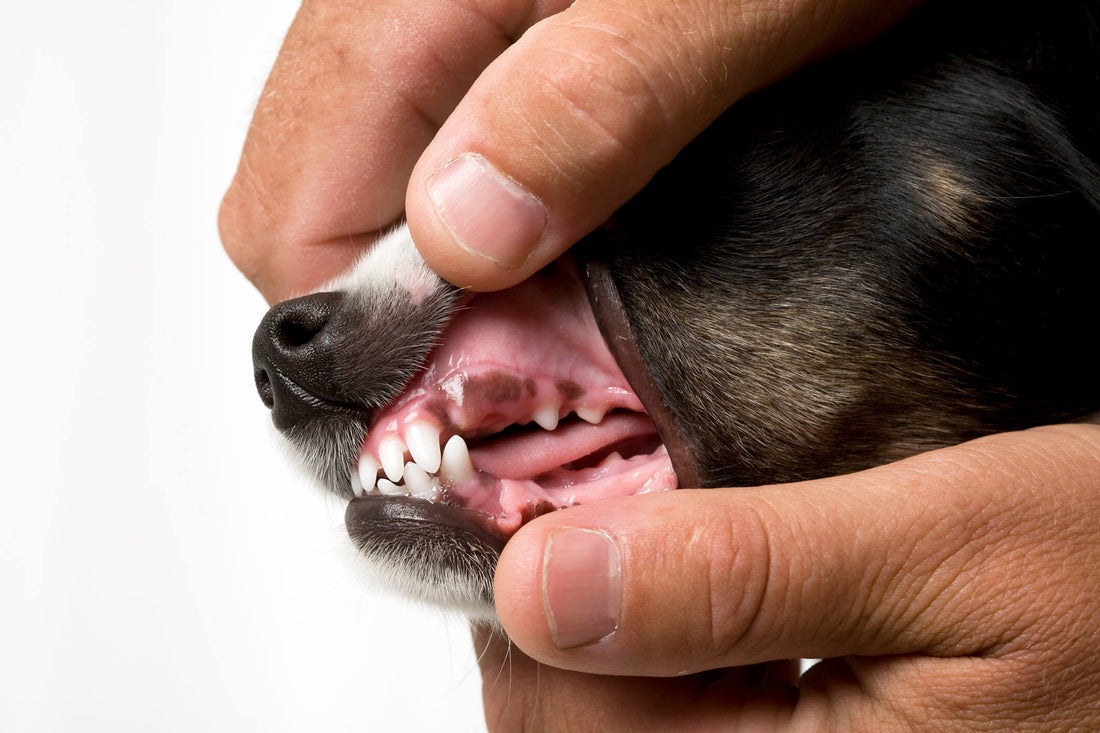
Do Your Dog's Gums Look Normal? Here's How to Tell
When is the last time you took a peek under your pup’s lips? You dog’s gums—the tissue that surrounds their teeth—might not be the first place you look if your dog is acting strangely, but they can tell you a surprising amount about your dog’s health!
Gum tissue acts as a protective barrier in your dog’s mouth, but its color, temperature and overall appearance can also serve as an indicator of a health problem. If you haven’t been paying attention to your pup’s gums, now is a good time to learn what healthy gums look like and what certain changes could mean.
What do healthy gums look like?
Healthy gums in dogs look a lot like healthy gums in humans. They should be a bright pink color all over. However, some dogs will have dark brown or black spots along their gums. As long as these dark spots are flat—not raised—they are nothing to be concerned about!
.jpg)
If you press on your dog’s gums, they should lighten to a pale pink or white color, then return to the usual pink quickly after. This indicates that the blood flow to your pup’s gums is normal. Their gums should also be smooth and slippery—not bumpy, uneven or dry.
Gum abnormalities to watch for
Checking your dog’s gums should be part of a consistent dental hygiene routine. Taking a closer look at the tissue on a regular basis can help you spot changes more easily and get your pup veterinary help as quickly as possible.
Before brushing your dog’s teeth, lift their lip to get a good visual of their gums on both sides, top and bottom. After examining how the gums look, run a clean finger along the gums, checking their temperature, texture and moisture.
If you think something is wrong with your dog’s gums, here are a few common abnormalities and what might be causing them.
- Red gums: Redness in the gums could mean a few different things. If the area where your dog’s teeth and gums meet is lined with red, they are likely experiencing gum inflammation (gingivitis) as a result of poor dental hygiene. Your dog might need a professional cleaning and/or more dental care at home to reduce plaque buildup. If the gums are bright red all over, your dog might be experiencing more advanced periodontal disease. Sometimes, heat stroke can also cause cherry-red gums.
- Bleeding gums: Your dog’s gums should not ever bleed. If you notice bleeding after you’ve brushed your pup’s teeth, the gums might be inflamed due to dental disease. However, if the bleeding occurs randomly, something more serious could be to blame. Perhaps your pup chewed on a toy too aggressively and injured the gums. If the bleeding doesn’t stop, it might be related to toxic poisoning or an infection.
- Gums with growths: Small bumps, lumps or ulcers on the gums are important to watch out for. Puppies are sometimes susceptible to viral warts on the gums and may need surgery to remove them if too many appear. Other bumps or ulcers could be related to oral cancers or infections. You’ll want to have your pup examined by the vet if you detect growths on your dog’s gums.
- Sticky or dry gums: Your dog’s gums should be slippery and wet to the touch. If they feel sticky or dry, instead, this usually means that your dog is dehydrated or potentially running a fever. Encourage your dog to drink more water throughout the day and monitor them for signs of a fever, just in case.
- White gums: Very pale pink or white gums often indicate that your dog has anemia—their red blood cell count is lower than it should be. When this happens, it’s usually a sign of a larger health problem, ranging from internal bleeding or trauma to poisoning to cancer. Any indication of anemia warrants a trip to the vet to determine the underlying cause.
- Blue gums: If your dog’s gums are turning blue, this means they aren’t getting enough oxygen and require veterinary help immediately! Your pup might not be able to breathe due to choking, pneumonia, heart failure or another issue and should be taken to the emergency vet right away.
- Yellow gums: Gums that appear even slightly yellow might indicate a problem with your dog’s liver. Yellow tissues are common in jaundice, a sign of liver disease, as well as Leptospirosis, a serious bacterial infection.
Clearly, your dog’s gums are capable of indicating much more than just their dental hygiene. Make a point to examine your pup’s gums regularly to stay on top of their health.


